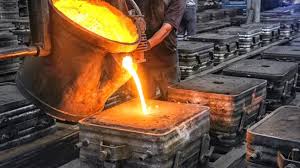Casting is a versatile manufacturing process used to create everything from jewelry to engine parts. This guide explores how raw materials are shaped into finished products, highlights common casting methods, and helps you choose the best one for your project.
Contents
What is Casting
Casting involves pouring liquid material into a mold, letting it cool and solidify, and then removing the finished part. Metal, plastic, and even ceramics can all be shaped using this process. The specific casting technique you choose will depend on factors like complexity, material, volume, and cost.
Why is Casting Important
Casting offers several unique benefits:
- Versatility for both complex and simple part shapes
- Cost-effectiveness at scale, especially for large quantities
- Ability to produce parts with excellent mechanical properties
- Suitable for both small and large components
Understanding the different casting methods can help you choose the most effective approach for your needs.
Sand Casting
Sand casting is the workhorse of the casting world. It’s flexible, widely used, and relatively low-cost. Here’s what you need to know:
Process Overview
- A pattern (a replica of the final product) is pressed into special sand to create a mold cavity.
- Molten metal is poured into this mold.
- Once the metal cools and solidifies, the sand mold is broken to reveal the finished piece.
Key Benefits
- Good for large or heavy parts
- Supports complex geometries and internal cavities
- Compatible with most metals, including steel, iron, and aluminum
- Cost-effective for low to moderate production volumes
Common Applications
- Engine blocks
- Machine bases
- Artistic sculptures
- Custom bronze plaque
Investment Casting
Investment casting offers unparalleled accuracy and a smooth surface finish. Sometimes known as “lost wax casting,” this method is ideal for detailed and delicate components.
Process Overview
- A wax model of the part is created.
- The wax model is coated with a ceramic shell.
- Once the shell hardens, the wax is melted out, leaving a detailed cavity.
- Molten metal is poured into the cavity, and after cooling, the ceramic shell is broken away to reveal the part.
Key Benefits
- Produces parts with excellent surface finish and fine details
- Minimal need for machining after casting
- Capable of casting small, intricate shapes and thin walls
Common Applications
- Jewelry
- Aerospace and automotive components
- Medical instruments
Die Casting
Die casting is a highly efficient process suitable for high-volume production, especially with non-ferrous metals like aluminum, magnesium, and zinc.
Process Overview
- Molten metal is injected at high pressure into a steel die (mold).
- The metal cools rapidly, and the part is ejected from the die.
Key Benefits
- High production rate and repeatability
- Excellent dimensional accuracy and smooth surface finish
- Minimal material waste
Common Applications
- Automotive parts (gears, housings, brackets)
- Consumer electronics housing
- Toys and small appliances
Gravity Casting
Gravity casting is a straightforward method typically used for non-ferrous metals, most often aluminum.
Process Overview
- Molten metal flows into a metal mold under the force of gravity alone.
- After cooling and solidifying, the part is removed from the mold.
Key Benefits
- Simple process with fewer moving parts
- Suitable for medium production volumes
- Good mechanical properties and surface finish
Common Applications
- Cylinder heads
- Valve bodies
- Pump housings
Centrifugal Casting
Centrifugal casting uses centrifugal force to distribute molten metal in a spinning mold, creating parts with excellent density and mechanical properties.
Process Overview
- The mold is rotated at high speed as molten metal is poured in.
- Centrifugal force pushes the metal outward against the mold walls.
- This results in a dense, uniform part, free from impurities.
Key Benefits
- Ideal for producing cylindrical parts with high structural integrity
- Minimal defects and excellent metallurgical quality
Common Applications
- Pipes and tubes
- Bushings
- Rings and sleeves
Continuous Casting
Continuous casting is primarily used in the steel industry for mass-producing billets, rods, and slabs.
Process Overview
- Molten metal is continuously poured into a cooled mold.
- The solidified metal is withdrawn in a steady stream and cut to the desired length.
Key Benefits
- High production efficiency
- Uniform metallurgical structure and properties
- Consistent cross-sectional shapes
Common Applications
- Steel and aluminum stock for further processing
- Copper rods and billets
Choosing the Right Casting Method
Selecting the appropriate casting method comes down to:
- Material type (ferrous or non-ferrous)
- Complexity and size of the part
- Production volume
- Required surface finish and accuracy
- Cost considerations
Consulting with casting experts or manufacturers can ensure you get the best fit for your application, balancing quality, cost, and lead time.
Conclusion
Casting methods have evolved to meet the demands of modern manufacturing. Whether you need a single detailed component or a million identical parts, there’s a casting method tailored to your needs.


